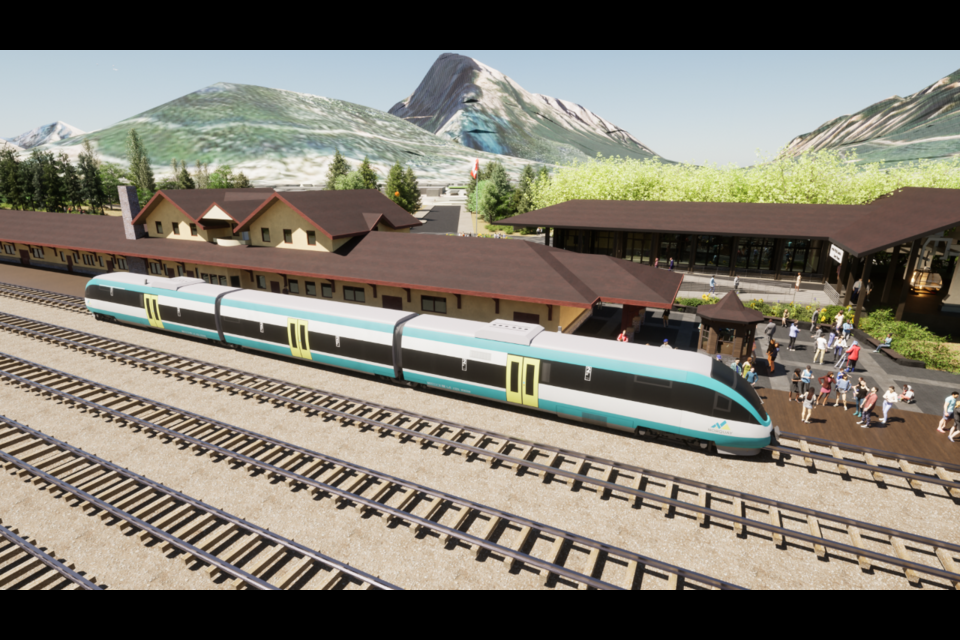Residents of Cochrane and Stoney Nakoda Nation may soon be able to buy a ticket to get on the next train to Banff or Calgary International Airport, or somewhere in between.
Banff-based Liricon Capital Ltd., who own Norquay ski resort, and Quebec-based Plenary Americas, are co-developing the $1.5-billion project and submitted an updated proposal last week to Alberta Transportation, Invest Alberta Corporation and the Canada Infrastructure Bank (CIB) to move from the development phase into design.
The Calgary Airport-Banff Passenger Rail (CABR) line would be built within the existing CP Rail freight corridor and according to a press release, would provide "high frequency, reliable service between seven stations: Calgary Airport, Calgary Downtown, Calgary Keith, Cochrane, Morley (Stoney Nakoda), Canmore and Banff."
If all goes according to plan, the potentially hydrogen-powered passenger rail could be on track to run as early as 2025, which Cochrane mayor Jeff Genung said is a timeline he remains cautiously optimistic about.
"We have roughly four years to plan and that's exciting because it's soon, and not 20 years away still," he said, adding that he has been a proponent of the project for several years.
"On the flip side of that, it also makes me nervous as we only have four years to get our own plans in place," he said with a laugh. "It's a good problem to have and I know there's communities across the country that would jump at an opportunity like Cochrane has here."
While they have yet to get into that level of detail with developers, Genung said it is most likely that it would be up to each community to allocate funding to build their own platforms for stops along the line and is something council will need to look at putting in their 10-year capital plan, to plan and save for.
What they have done already, is left an open slot of land behind the developing transit hub for a train station with exactly this project in mind.
"That's the exciting part of this whole project is we've kind of pencilled things in but now we can maybe start to solidify some of these ideas and really map out what our downtown core is going to look like," he said.
Albertans could buy a ticket to ride from Calgary to Banff for about $20 and trains would be expected to stop in Cochrane every two hours.
The plan for the rail project is to keep fare costs relatively low with the tourist market subsidizing the commuter market. Most of the costs would be picked up by tourists travelling from the airport to Banff.
The line has the potential to provide a boost to each community's tourist and job economies, while also reducing traffic, emissions, and creating a stress-free method of transport to and from the mountains, especially in winter.
Liricon and Plenary's proposal seeks a Government of Alberta annual performance payment of $30 million per year, with payments beginning the year after construction, contingent upon the performance of the train.
The proposal is structured as a public-private-partnership (P3), which contemplates financing from private and institutional capital and the Canada Infrastructure Bank.
Under the plan, the P3 and CIB will contribute all the $1.5 billion in capital costs and operate the system.
The proposal is based on a feasibility study that was done and paid for by CIB, a federal Crown corporation established three years ago that funds public interested projects expected to generate revenue.
The study found that 2.2 million tourists land at the Calgary Airport every year to go directly to Banff, without stopping in between.
"The rail model contemplates that 20 per cent of those would use the rail," said Genung. "If even a fraction of the 20 per cent were to stop in Cochrane to shop at our local businesses, maybe stay overnight — maybe there would be opportunity for another hotel to move to Cochrane, the possibilities are endless, and all positive."
With the amount of recent investment into Cochrane's transportation infrastructure through roadway improvements, the building of the Jack Tennant bridge, introduction of COLT and Roll scooters, Genung said he believes the rail project could be a nice dovetail.
There will need to be some additional planning around parking and pedestrians, he added, but locally, he suggested building the platform and other necessary infrastructure could feasibly be done through a phased approach.




